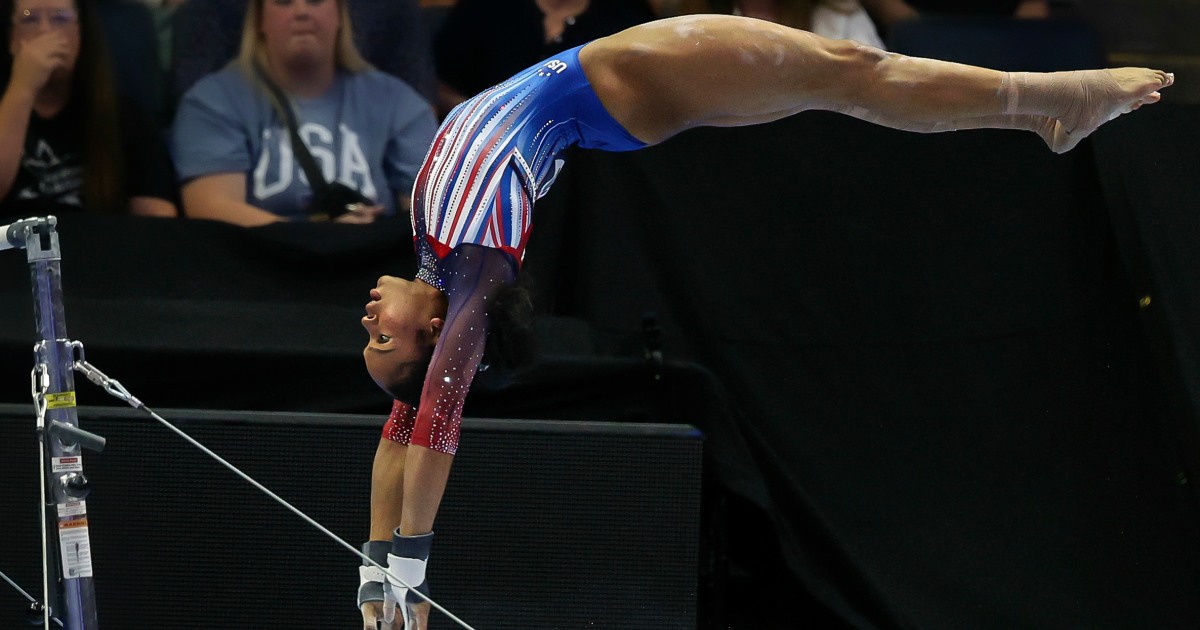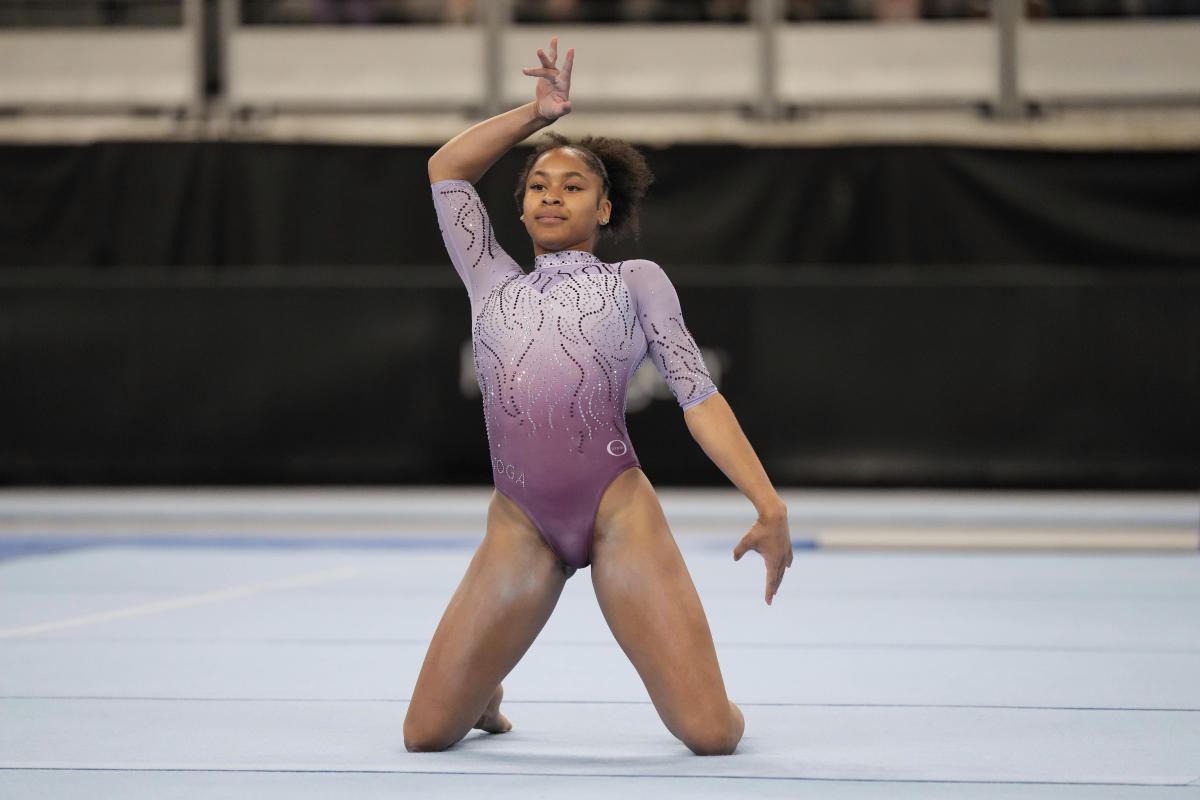Gymnastic Injuries at Olympic Trials
Gymnastics olympic trials injury – Gymnastics is a demanding sport that requires athletes to perform complex and physically challenging skills. As a result, gymnasts are at risk for a variety of injuries, especially during the intense training and competition period leading up to the Olympic trials.
In the lead-up to the gymnastics Olympic trials, injuries plagued the men’s gymnastics team , threatening their chances of a podium finish. Despite the setbacks, the team remained resilient, determined to overcome adversity. The trials would be a testament to their unwavering spirit and the indomitable will that drives gymnasts to push their bodies to the limit in pursuit of Olympic glory.
The most common types of injuries gymnasts face during Olympic trials include:
- Muscle strains and sprains: These are the most common type of injury in gymnastics, and they can occur in any muscle or ligament in the body.
- Tendonitis: This is inflammation of a tendon, which is the tissue that connects muscle to bone.
- Bone fractures: These are breaks in the bone, and they can occur in any bone in the body.
- Concussions: These are head injuries that can occur when an athlete hits their head on a hard surface.
There are a number of factors that contribute to injuries in gymnasts, including:
- Intense training: Gymnasts train for many hours each day, and this can put a lot of stress on their bodies.
- Competition pressure: The Olympic trials are a high-pressure event, and this can lead to gymnasts pushing themselves too hard.
- Improper technique: If gymnasts do not use proper technique when performing their skills, they are more likely to get injured.
- Inadequate warm-up: Warming up properly before training or competition can help to prevent injuries.
Injuries can have a significant impact on gymnasts’ performance and overall well-being. A serious injury can sideline a gymnast for months or even years, and it can also lead to long-term pain and disability.
As the gymnastics olympic trials draw near, the specter of injury looms large. Gymnasts push their bodies to the limit, and injuries are an unfortunate reality. From sprains and strains to more serious injuries like fractures and dislocations, gymnasts face a wide range of potential gymnastics injuries.
Despite the risks, gymnasts continue to train and compete, driven by their passion for the sport. However, it is important to remember that injuries can have a lasting impact, and it is crucial for gymnasts to take steps to prevent them and to seek proper treatment if they do occur.
Preventing Injuries
There are a number of things gymnasts can do to prevent injuries, including:
- Train properly: Gymnasts should train with a qualified coach who can help them to develop proper technique and avoid injuries.
- Warm up properly: Warming up properly before training or competition can help to prevent injuries.
- Listen to their bodies: Gymnasts should pay attention to their bodies and stop training if they are feeling pain.
- Get enough rest: Gymnasts need to get enough rest so that their bodies can recover from training.
- Eat a healthy diet: Eating a healthy diet can help gymnasts to stay strong and healthy.
By following these tips, gymnasts can help to reduce their risk of injury and improve their overall performance.
Prevention and Treatment of Gymnastics Injuries: Gymnastics Olympic Trials Injury

Gymnastics is a demanding sport that requires immense physical strength, flexibility, and coordination. However, the rigorous training and high-impact maneuvers involved also make gymnasts susceptible to a range of injuries. Preventing and effectively treating these injuries is crucial for ensuring the well-being and performance of gymnasts.
Injury Prevention
Preventing injuries during Olympic trials requires a comprehensive approach that encompasses proper training techniques, injury prevention exercises, and adequate rest and recovery.
- Proper Training Techniques: Gymnasts should receive proper instruction and supervision from qualified coaches who emphasize correct form and technique. This helps reduce the risk of acute injuries caused by improper execution of skills.
- Injury Prevention Exercises: Incorporating exercises that strengthen core muscles, improve flexibility, and enhance proprioception can help prevent injuries by stabilizing joints and improving body awareness.
- Adequate Rest and Recovery: Allowing sufficient time for rest and recovery between training sessions and competitions is essential for muscle repair, reducing fatigue, and preventing overuse injuries.
Treatment Options
Despite preventive measures, injuries can still occur. When they do, prompt and appropriate treatment is necessary to facilitate recovery and prevent further complications.
- Physical Therapy: Physical therapy plays a vital role in injury rehabilitation. Therapists use various techniques, such as manual therapy, exercises, and modalities, to reduce pain, improve mobility, and restore function.
- Rehabilitation: Rehabilitation programs are designed to gradually increase the intensity and complexity of exercises to restore strength, range of motion, and coordination. This helps gymnasts regain their pre-injury performance levels.
- Surgery: In some cases, surgery may be necessary to repair or reconstruct damaged tissues. However, surgery is typically considered a last resort after conservative treatment options have failed.
Advancements in Injury Prevention and Treatment, Gymnastics olympic trials injury
Research and innovation in gymnastics have led to significant advancements in injury prevention and treatment methods.
- Wearable Technology: Wearable sensors and devices can monitor an athlete’s movement patterns, identify potential risks, and provide real-time feedback to prevent injuries.
- Biomechanical Analysis: Advanced biomechanical analysis techniques help coaches and medical professionals assess an athlete’s technique and identify areas for improvement, reducing the risk of injuries.
- Regenerative Medicine: Emerging therapies, such as platelet-rich plasma (PRP) and stem cell therapy, have shown promise in promoting tissue healing and reducing recovery time.
Case Studies of Notable Gymnastics Injuries at Olympic Trials

Olympic trials are a highly competitive and demanding event, where gymnasts push their bodies to the limits. As a result, injuries are not uncommon. Some of the most notable gymnastics injuries at Olympic trials have had a significant impact on the gymnasts’ careers.
One of the most famous examples is the injury suffered by Kerri Strug at the 1996 Olympics. Strug injured her ankle on her first vault, but she returned to the competition and performed a second vault on one leg, helping the United States team win the gold medal. Strug’s injury was a major turning point in her career, as she was forced to retire from gymnastics shortly after the Olympics.
Another notable gymnastics injury at Olympic trials occurred in 2008, when Nastia Liukin injured her ankle during the all-around competition. Liukin was able to continue competing, but her injury limited her performance and she finished second to Shawn Johnson. Liukin’s injury was a setback, but she was able to recover and win the all-around gold medal at the 2008 Olympics.
These are just two examples of the many gymnasts who have suffered injuries at Olympic trials. These injuries can have a significant impact on the gymnasts’ careers, but they can also be a source of inspiration for others. The gymnasts who have overcome their injuries and returned to competition are a testament to the strength and resilience of the human spirit.
Injury Prevention and Treatment
There are a number of things that gymnasts can do to prevent injuries. These include:
- Warming up properly before each workout
- Cooling down properly after each workout
- Stretching regularly
- Eating a healthy diet
- Getting enough sleep
If a gymnast does suffer an injury, it is important to seek medical attention as soon as possible. The doctor will be able to diagnose the injury and recommend the best course of treatment.
Rehabilitation
The rehabilitation process for a gymnastics injury can be long and difficult. However, it is important to be patient and follow the doctor’s instructions. The rehabilitation process typically involves:
- Rest
- Physical therapy
- Massage
- Acupuncture
The goal of rehabilitation is to help the gymnast regain their full range of motion and strength. The gymnast may also need to make changes to their training program to avoid re-injuring themselves.
Return to Competition
Once a gymnast has recovered from their injury, they can begin to return to competition. It is important to start slowly and gradually increase the intensity of their training. The gymnast should also listen to their body and take breaks when they need them.
Returning to competition after an injury can be a daunting task. However, with patience and perseverance, the gymnast can regain their confidence and return to their previous level of performance.
